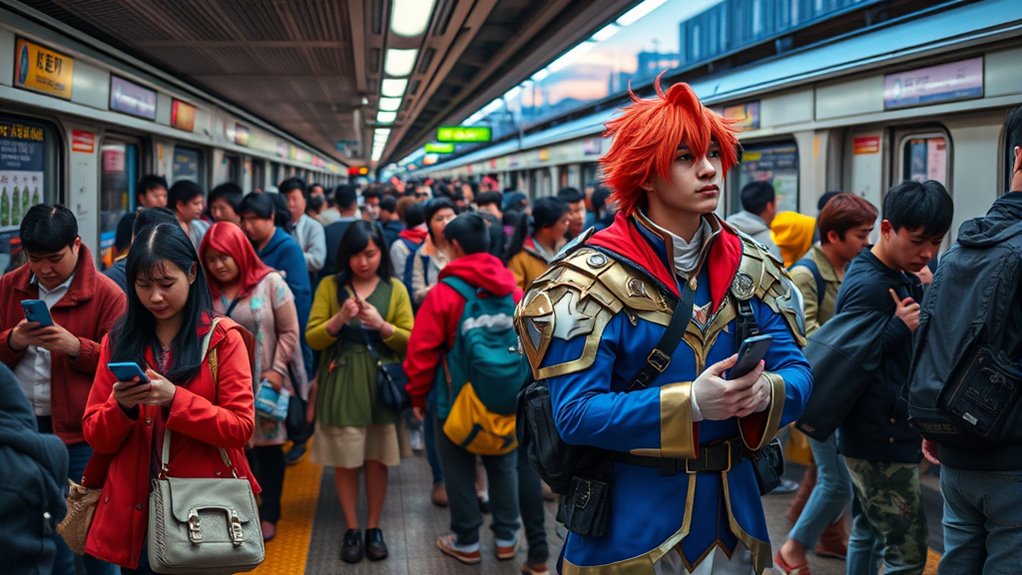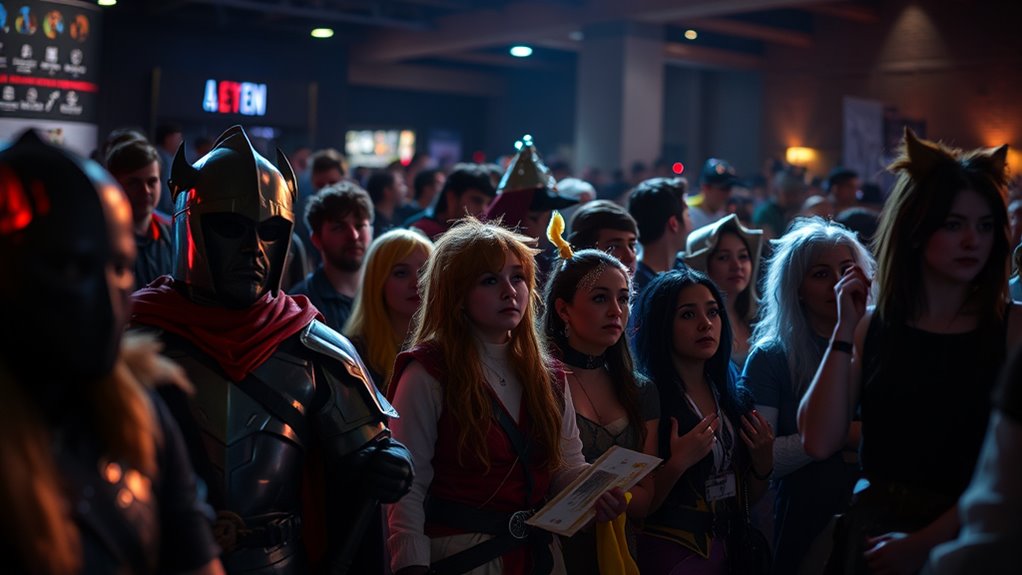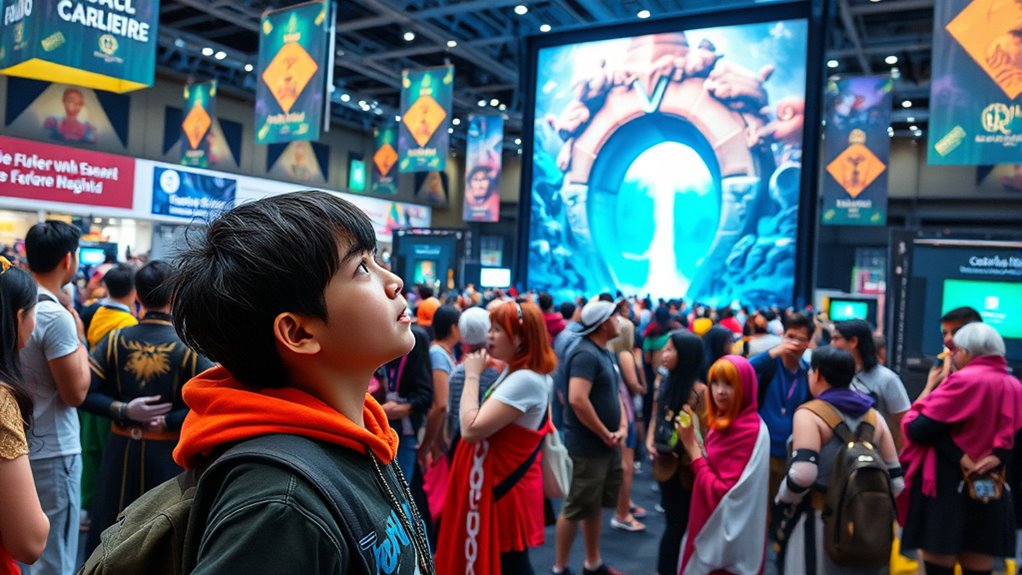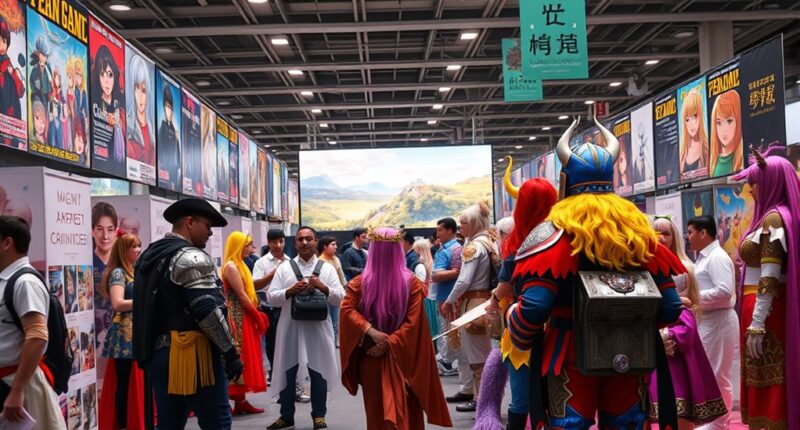The rise of isekai stories reflects both your desire to escape and explore deeper social issues through fantasy worlds. These tales started as simple escapes but have evolved into complex narratives that mirror real-world struggles like inequality and environmental concerns. They use familiar characters and themes to connect with you emotionally while offering adventure and reflection. If you keep exploring, you’ll discover how this genre provides more than just escapism—it’s a mirror to society’s hopes and flaws.
Key Takeaways
- Isekai offers immersive escapism, allowing audiences to leave real-world issues behind through fantasy worlds.
- It also serves as social commentary, highlighting societal flaws like inequality and environmental concerns via allegorical narratives.
- The genre reflects a shift from simple escapism to complex storytelling, incorporating layered characters and nuanced themes.
- Archetypes in Isekai mirror real-world roles, fostering emotional connections and social understanding.
- Future trends, including technology integration, suggest Isekai will continue blending entertainment with social reflection.
The Origins and Evolution of Isekai Genre

The origins of the isekai genre trace back to early Japanese literature, where stories often featured characters transported to fantastical worlds. Over time, this genre expanded, embracing a wide genre diversity that includes action, romance, comedy, and even horror. You’ll notice how storytelling techniques evolved, blending traditional tropes with modern innovations. Early works relied on straightforward narratives, but today’s isekai stories often incorporate complex world-building and layered character development. This evolution reflects a shift from simple escapism to more nuanced storytelling, appealing to diverse audiences. Whether through light novels, manga, or anime, the genre’s versatility allows creators to experiment with different styles and themes, making isekai a dynamic and continually evolving form of entertainment rooted in its rich literary origins. Additionally, cultural influence plays a significant role in shaping the themes and popularity of isekai stories worldwide.
Themes of Escapism and Desire for Adventure

Have you ever wondered why so many are drawn to isekai stories? It’s because they offer virtual escapades where you can leave behind everyday struggles and plunge into worlds of fantasy fulfillment. These stories tap into a deep desire for adventure, allowing you to experience heroism, magic, and new identities without real-world risks. In a way, isekai provides a safe space to explore fantasies that might seem out of reach, fueling the longing for excitement and novelty. This theme reflects a common human craving for escape, where the allure of another universe becomes an appealing alternative to mundane routines. Additionally, the contrast ratio in storytelling can heighten the emotional impact of these worlds, making the experiences feel more vivid and immersive. Through these journeys, viewers or readers vicariously satisfy their yearning for thrill, discovery, and a fresh start.
Societal Reflections and Underlying Messages

Many isekai stories subtly mirror societal issues and values, offering more than just escapism. Through fantasy escapism, they often serve as a societal critique, highlighting real-world problems in a fictional setting. These stories reflect desires for fairness, power dynamics, or environmental concerns, indirectly commenting on current social struggles. By placing characters in alternate worlds, creators explore themes like inequality, technology’s impact, or cultural values, prompting viewers to reflect on their own society. This layered storytelling invites audiences to question norms while enjoying a fantastical journey. Instead of solely escaping reality, you’re encouraged to see it differently, recognizing underlying messages about societal flaws and hopes for change. Incorporating home improvement themes, such as organization and decluttering, into these narratives can further emphasize the importance of social harmony and personal responsibility. Isekai therefore becomes a mirror, revealing hidden truths beneath its adventurous surface.
Character Archetypes and Audience Identification

Character archetypes in isekai stories often serve as a bridge for viewers to see themselves in fantastical worlds. These characters embody familiar traits that reflect real-world gender roles, making it easier for you to identify with their struggles and victories. In fantasy worlds, archetypes like the hero, the strategist, or the healer help you connect emotionally and understand different perspectives. Here are some common archetypes:
- The Overpowered Protagonist – often breaks traditional gender roles by defying stereotypes.
- The Wise Mentor – guides others, representing maturity regardless of gender.
- The Loyal Sidekick – supports the hero, reinforcing or challenging gender expectations.
- The Enigmatic Stranger – adds mystery, often breaking conventions of gender portrayal.
These archetypes shape your experience, making fantasy worlds feel familiar and engaging.
The Cultural Impact and Future Trends of Isekai

The rise of isekai stories has markedly influenced global pop culture, shaping perceptions of fantasy, escapism, and social values. You now see virtual escapism as a way to explore worlds beyond reality, offering an immersive experience that resonates across diverse audiences. Isekai’s cultural fusion brings together elements from different traditions, creating unique narratives that appeal worldwide. This blending encourages innovative storytelling and broadens cultural understanding. Future trends suggest even more integration of technology, such as virtual reality, to deepen immersion. As isekai continues to evolve, it’ll likely serve as both a reflection of societal desires for escapism and a platform for cultural exchange. The incorporation of traditional storytelling techniques from various cultures further enriches these narratives, making them more relatable and engaging for a global audience. Your engagement with these stories highlights their growing significance in shaping perceptions of fantasy and social commentary.
Frequently Asked Questions
How Has Isekai Influenced Mainstream Western Media?
You’ve likely noticed how isekai has shaped mainstream western media by sparking genre evolution, blending fantasy and adventure into popular shows and movies. It captures your interest by boosting audience engagement through immersive worlds and relatable characters. This influence pushes creators to explore new storytelling styles, making content more dynamic and appealing. As a result, isekai’s impact extends beyond anime, transforming how western media approach fantasy and escapism.
Are There Psychological Effects Associated With Consuming Isekai Content?
You might find that consuming isekai content offers escapism effects, helping you temporarily escape reality’s stress. It can also encourage identity exploration as you relate to characters seeking purpose or transformation. However, overindulgence could lead to avoiding real-life issues. Be mindful of how these stories influence your perspective, balancing enjoyment with awareness that they serve as a fantasy escape rather than a substitute for real-world growth.
How Do Isekai Narratives Differ Across Various Cultures?
You notice that isekai narratives differ across cultures through unique storytelling styles and cultural interpretations. In Japan, they often emphasize heroism and personal growth, while Western versions may focus on individualism and adventure. These differences reflect each culture’s values and storytelling traditions, shaping how characters and worlds are portrayed. By exploring these variations, you gain insight into how diverse societies view escapism, morality, and identity through their distinct narrative lenses.
What Role Does Gender Play in Isekai Character Development?
You notice that gender influences isekai character development by often reinforcing stereotypes, like male heroes or female damsels. However, some stories challenge these norms, giving characters more agency regardless of gender. This dynamic shapes how you see characters’ roles and growth. As you explore, you realize that breaking gender stereotypes can lead to richer, more nuanced stories where characters aren’t confined by traditional expectations.
Can Isekai Serve as a Tool for Social Change?
Did you know over 80% of isekai stories explore escapism potential? You see, isekai can be a powerful tool for social change by raising social awareness through imaginative worlds. It allows you to reflect on real-world issues in a fantastical setting, encouraging empathy and understanding. So, by engaging with these stories, you might find yourself inspired to challenge societal norms or advocate for meaningful change.
Conclusion
While some see isekai as simple escapism, it actually offers deeper reflections on society and personal desires. You might think it’s just fantasy, but it’s also a mirror for exploring real-world issues and dreams. By embracing these stories, you can find meaning beyond the escapism, understanding that they serve as both entertainment and social commentary. So, next time you watch, remember—it’s more than just fantasy; it’s a window into ourselves.









